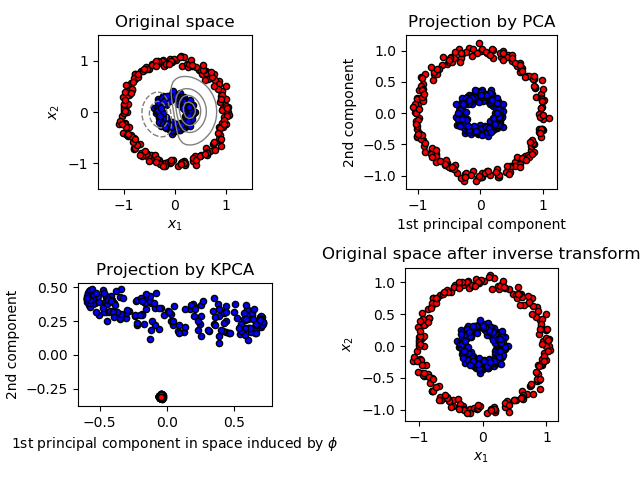sklearn.decomposition.KernelPCA?
class sklearn.decomposition.KernelPCA(n_components=None, *, kernel='linear', gamma=None, degree=3, coef0=1, kernel_params=None, alpha=1.0, fit_inverse_transform=False, eigen_solver='auto', tol=0, max_iter=None, remove_zero_eig=False, random_state=None, copy_X=True, n_jobs=None)
內核主成分分析(KPCA)
通過使用內核減少非線性維數(請參閱成對度量,近似關系和內核)。
在用戶指南中閱讀更多內容。
| 參數 | 說明 |
|---|---|
| n_components | int, default=None 組件數。如果為None,則將保留所有非零分量。 |
| kernel | “linear” , “poly” , “rbf” ,“sigmoid” , “cosine” , “precomputed” 內核。默認值為“linear”。 |
| gamma | float, default=1/n_features rbf,poly和Sigmoid內核的內核系數。被其他內核忽略。 |
| degree | int, default=3 多核度。被其他內核忽略。 |
| coef0 | float, default=1 poly核和sigmoid核中的獨立項。被其他內核忽略。 |
| kernel_params | mapping of string to any, default=None 作為可調用對象傳遞的內核的參數(關鍵字參數)和值。被其他內核忽略。 |
| alpha | int, default=1.0 嶺回歸的超參數,用于學習逆變換(當fit_inverse_transform = True時)。 |
| fit_inverse_transform | bool, default=False 了解非預計算內核的逆變換。(即學會找到一個點的原像) |
| eigen_solver | string [‘auto’,’dense’,’arpack’], default=’auto’ 選擇要使用的特征求解器。如果n_components遠小于訓練樣本的數量,則arpack可能比密集特征求解器更有效。 |
| tol | float, default=0 arpack的收斂容限。如果為0,則arpack將選擇最佳值。 |
| max_iter | int, default=None arpack的最大迭代次數。如果為None,則arpack將選擇最佳值。 |
| remove_zero_eig | boolean, default=False 如果為True,則將刪除所有具有零特征值的分量,以使輸出中的分量數可能小于n_components(有時由于數字不穩定性甚至為零)。當n_components為None時,將忽略此參數,并刪除特征值為零的組件。 |
| random_state | int, RandomState instance, default=None 在 eigen_solver=='arpack'時使用。在多個函數調用之間傳遞int以獲得可重復的結果。請參閱詞匯表。版本0.18中的新功能。 |
| copy_X | boolean, default=True 如果為True,則模型將復制輸入X并將其存儲在 X_fit_ 屬性中。如果對X不再做任何更改,則該設置copy_X=False將通過存儲引用來 節省內存。版本0.18中的新功能。 |
| n_jobs | int or None, optional (default=None) 要運行的并行作業數。 None除非joblib.parallel_backend上下文中,否則表示1 。 -1表示使用所有處理器。有關 更多詳細信息,請參見詞匯表。版本0.18中的新功能。 |
| 屬性 | 說明 |
|---|---|
| lambdas_ | array, (n_components,) 中心核矩陣的特征值以降序排列。如果 n_components和remove_zero_eig均未設置,則將存儲所有值。 |
| alphas_ | array, (n_samples, n_components) 中心核矩陣的特征向量。如果 n_components和 remove_zero_eig均未設置,則將存儲所有組件。 |
| dual_coef_ | array, (n_samples, n_features) 逆變換矩陣。僅當 fit_inverse_transform為True 時可用 。 |
| X_transformed_fit_ | array, (n_samples, n_components) 擬合數據在內核主成分上的投影。僅當 fit_inverse_transform為True 時可用。 |
| X_fit_ | (n_samples, n_features) 用于擬合模型的數據。如果為 copy_X=False,則X_fit_為參考。此屬性用于進行轉換的調用。 |
參考文獻
內核PCA引入于:
Bernhard Schoelkopf, Alexander J. Smola, and Klaus-Robert Mueller. 1999. Kernel principal component analysis. In Advances in kernel methods, MIT Press, Cambridge, MA, USA 327-352.
例子
>>> from sklearn.datasets import load_digits
>>> from sklearn.decomposition import KernelPCA
>>> X, _ = load_digits(return_X_y=True)
>>> transformer = KernelPCA(n_components=7, kernel='linear')
>>> X_transformed = transformer.fit_transform(X)
>>> X_transformed.shape
(1797, 7)
方法
| 方法 | 說明 |
|---|---|
fit(X[, y]) |
根據X中的數據擬合模型。 |
fit_transform(X[, y]) |
根據X中的數據擬合模型并轉換X。 |
get_params([deep]) |
獲取此估計量的參數。 |
inverse_transform(X) |
將X轉換回原始空間。 |
set_params(**params) |
設置此估算器的參數。 |
transform(X) |
轉換X。 |
__init__(n_components=None, *, kernel='linear', gamma=None, degree=3, coef0=1, kernel_params=None, alpha=1.0, fit_inverse_transform=False, eigen_solver='auto', tol=0, max_iter=None, remove_zero_eig=False, random_state=None, copy_X=True, n_jobs=None)
初始化self。請參閱help(type(self))獲取準確的信息。
fit(X, y=None)
根據X中的數據擬合模型。
| 參數 | 說明 |
|---|---|
| X | array-like, shape (n_samples, n_features) 訓練向量,其中樣本數量為n_samples個,特征數量為n_features個。 |
| 返回值 | 說明 |
|---|---|
| self | object 返回實例本身。 |
fit_transform(X, y=None, **params)
根據X中的數據擬合模型并轉換X。
| 參數 | 說明 |
|---|---|
| X | array-like, shape (n_samples, n_features) 訓練向量,其中樣本數量為n_samples個,特征數量為n_features個。 |
| 返回值 | 說明 |
|---|---|
| X_new | array-like, shape (n_samples, n_components) |
get_params(deep=True)
獲取此估計量的參數。
| 參數 | 說明 |
|---|---|
| deep | bool, default=True 如果為True,則將返回此估算器和其所包含子對象的參數。 |
| 返回值 | 說明 |
|---|---|
| params | mapping of string to any 參數名稱映射到其值。 |
inverse_transform(X )
將X轉換回原始空間。
| 參數 | 說明 |
|---|---|
| X | array-like, shape (n_samples, n_components) |
| 返回值 | 說明 |
|---|---|
| X_new | array-like, shape (n_samples, n_features) |
參考文獻
“Learning to Find Pre-Images”, G BakIr et al, 2004.
set_params(**params)
設置此估算器的參數。
該方法適用于簡單的估計器以及嵌套對象(例如管道)。后者具有<component>__<parameter>形式的參數, 以便可以更新嵌套對象的每個組件。
| 參數 | 說明 |
|---|---|
| **params | dict 估算器參數。 |
| 返回值 | 說明 |
|---|---|
| self | object 估算器實例。 |
transform(X )
轉換X。
| 參數 | 說明 |
|---|---|
| X | array-like, shape (n_samples, n_features) |
| 返回值 | 說明 |
|---|---|
| X_new | array-like, shape (n_samples, n_components) |

